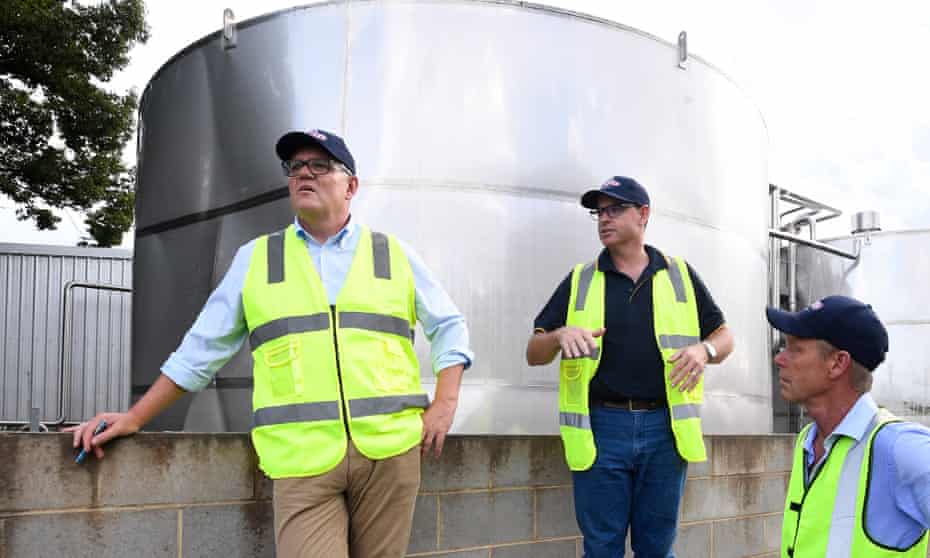Extract from The Guardian
Scott Morrison brings his signature crisis characteristics – passivity and blame shifting – to Lismore.

Australia was becoming a harder country to live in because of natural disasters, like the black summer bushfires, and the latest catastrophic floods that have killed more than 20 people. “We are dealing with a different climate to the one we are dealing with before,” the prime minister said.
Morrison turned up with practical support. Cash. Promises of more defence personnel to clear out the rubbish (although that might take a month). He also opened the door on a conversation about what might need to be done locally to mitigate risk, with commonwealth funds on standby.
But there was also plenty of passivity and blame shifting, which are Morrison’s core crisis characteristics.
We’ve seen these same instincts flare during the bushfires, during the pandemic, and now during the floods. These qualities are now very familiar. It’s part of the reason the prime minister has lost standing with voters.

On Wednesday, Morrison thought any inquiry into the quality of the disaster response in the northern rivers was a matter for the New South Wales government – not him.
Morrison also thought a failure to scramble significant defence resources into the disaster zone was not actually a failure. The problem was people had unrealistic expectations about what governments could do. The prime minister noted people would always need to rely on their neighbours when catastrophe struck as opposed to a functioningtriple zero emergency service (that the Morrison government most decidedly did not run – that was Dominic Perrottet’s responsibility).
But all of this was warm up laps for peak passivity.
As might have been predicted, Morrison hit peak passivity when pressed about his government’s record on the climate crisis.
Morrison pretended the Coalition had always been on board with climate change despite the voluminous evidence to the contrary (including, but not limited to, the repeal of a functioning carbon price, Tony Abbott’s serious attempt to gut the renewable energy target, and, more recently, Morrison’s own hyper-partisan masterstroke, the entirely bogus “war on the weekend”).
Morrison suggested his government had been so forward leaning on climate action it had been “the first government to commit by net zero by 2050”.
Given Australia was one of the last countries in the developed world to actually make that commitment, and almost didn’t because of trenchant opposition from the National party – this first-cab-off-the-rank data point was perplexing to say the least.
But in any case, lest all this forward leaning seem too forward, Morrison wrenched his bus into reverse. The prime minister proceeded to treat onlookers to one of his favourite tutorials: Australia makes bugger all difference when it comes to global climate action.
We need to remind ourselves that this self-serving pontification by Morrison was occurring at the site of an actual disaster zone on the frontline of the climate crisis, while the traumatised residents of Lismore were milling outside still trying to process what the hell just happened.
Sure, global heating was real enough, but Morrison reminded people Australia was an emissions minnow, and nothing would stop global emissions rising until countries with rising emissions profiles were given access to technology enabling them to cut pollution. Anything else was just “warm fuzzy feelings”.
This version of events – one that pretends demonstrable public policy failure has no costs or consequences – glosses over inconvenient truths like if runaway heating is a global problem (and it is), it can only be solved by rich countries like Australia pulling their weight. If every country acted with the abject derangement that Australia has exhibited for a decade, then the planet will most decidedly cook.
Another fact. Australia continues to export emissions that contribute to heating to the rest of the world like that ain’t no thing. One last fact. While Morrison was acknowledging the reality of the changing climate in Lismore, his energy minister Angus Taylor was out making the case for a further expansion of fossil fuels, and taunting European countries for not pursuing a “gas-fired recovery”.
This leads us to the nub of the problem.
Australia has struggled to get its disaster response right in part because federations are always complicated and imperfect beasts, and in part, because the Morrison government refuses to pull hard on the thread that will unravel the Coalition’s whole climate culture war.

Getting the national disaster response right requires something radical.
It requires the Coalition to be honest about the past, and about the future.
To give Australians the tools they need to manage the existential threat of a heating climate, this government needs to be honest, first with itself, and then with the Australian public, about the nature of the threat. It needs to end a decade of excuses, evasions and obfuscations, and set about atoning for them.
Until this government understands the magnitude of its own policy failures, until it can permit the most basic truth telling, this group of people will not be able to summon the imagination or the resolve, let alone the monumental whole-of-federation resources required to mitigate the risks and adapt to the new realities.
That’s the truth.
No comments:
Post a Comment